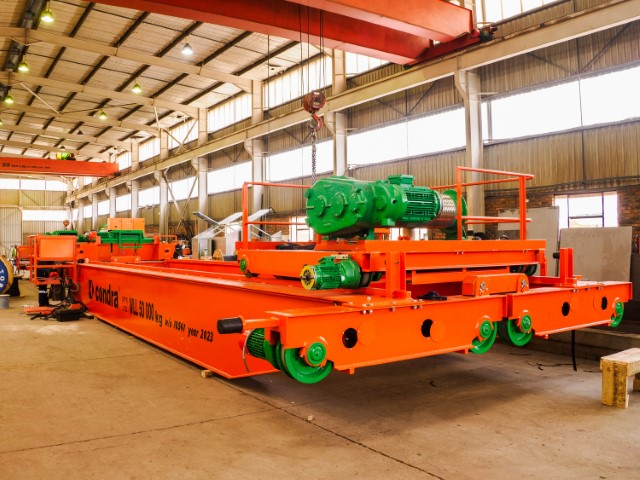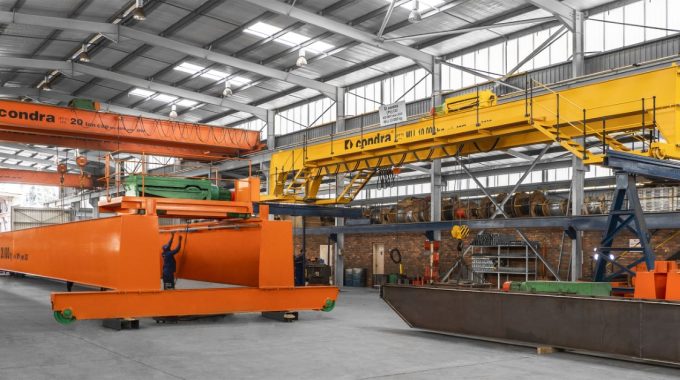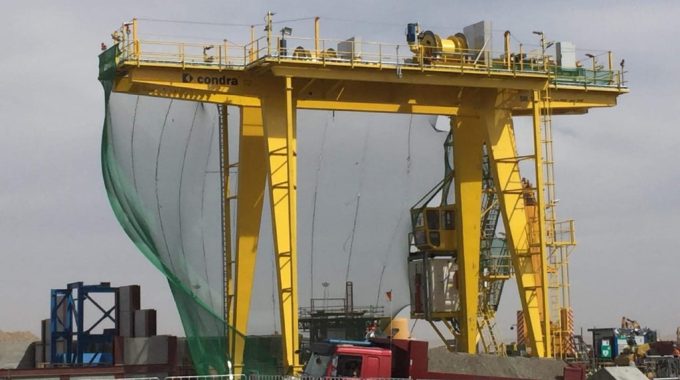40 NOT OUT
A 40-ton electric overhead travelling crane manufactured and commissioned 39 years ago is being refurbished at Condra’s main factory in Germiston, just a few months short of the machine’s ruby anniversary.
The 21-metre-span double-girder crane is used for maintenance duties at an Mpumalanga power station. Its three-week overhaul and refurbishment will ensure continued operation into the future.
Delivered and installed in 1985, the crane has an interesting history. Condra received the order to manufacture it while still based in Elsburg, where the company had recently moved in order to manage production of an expanding product range. Since that time, Condra has moved to even bigger premises, introduced two new lines of hoists, extended its crane offering to include telescopic, automated, process and cantilever cranes, and expanded to occupy four separate factories in South Africa, Europe and South America.
The 40-ton power station crane has remained reliably in service through all these changes, being upgraded eleven years ago by the fitment of an additional, faster, 16-ton hoist to be used for smaller workshop tasks. The refurbishment retains this smaller auxiliary machine, but will replace two 20-ton hoists with a single 40-ton unit reeved to deliver a central lift. Power will come from a two-speed 36kW/12kW motor.
Originally, the twin 20-ton hoists were reeved together and mounted on the same crab to achieve the 40-ton capacity. The single 40-ton replacement hoist will be installed on an improved crab delivering a variable cross-travel speed of up to 20 metres per minute. The hoist itself has fixed lifting speeds, but will be equipped to allow fitment of variable speed drives in the future. Lifting height is eight metres. Overhaul of the long travel is to be carried out by the customer.
When the upgrade is complete, the reinstalled crane will deliver a precise and substantially improved handling capability, and carry the same two-year warranty as a new crane. Delivery back to the power station is scheduled for this month (March).
Pointing to the almost 40 years’ uninterrupted service of this particular crane, a spokesman for Condra said that product reliability means that only six to eight percent of company turnover comes from refurbishments.
“Refurbishment work is usually only carried out on Condra products,” he said. “We do not actively seek cranes from rival firms because of cost, which is usually very high because of imported spare parts. Spares for Condra cranes are manufactured locally.”
“Crane refurbishment is usually well worthwhile,” he continued. “We encourage it because new crane prices are 60% higher today than they were 10 years ago.

“There are examples of Condra cranes being sold second-hand for their original purchase price, so crane refurbishment makes a lot of sense. But we are not doing as many refurbishments as might be expected because our products last a long time, and because we very quickly repair existing crane installations. For a refurbishment we need a little more time, usually two to three weeks.”
Advantages of refurbishment over buying new include an immediate realisation of cost savings over buying new, and the continued use of an as-new machine already familiar to the crane operators, avoiding any need for retraining. Production can continue as before, with no change to established procedure.
Condra offers the option of changing crane capacity and span. Cranes 20 years or older can usually be improved by installing variable frequency drives to facilitate acceleration and deceleration. Enhancements such as a digital read-out on the load and remote control can also be fitted.
“With refurbishment we can give back to the customer a crane that is much faster and much lighter than it was before, and we can fit a frequency drive on the long travel to speed it up, and we can incorporate in the refurbishment any kind of modern technology that he wants, including hoists of different capacity,” the spokesman said.
“We can also automate the crane, in which case we improve the mechanicals to incorporate new electrical equipment.”
“These options are offered across the board during any refurbishment, from standard 2M workshop cranes to the higher performing machines such as Class 3 and Class 4,” the spokesman concluded.
The 21-metre-span double-girder crane is used for maintenance duties at an Mpumalanga power station. Its three-week overhaul and refurbishment will ensure continued operation into the future.
Delivered and installed in 1985, the crane has an interesting history. Condra received the order to manufacture it while still based in Elsburg, where the company had recently moved in order to manage production of an expanding product range. Since that time, Condra has moved to even bigger premises, introduced two new lines of hoists, extended its crane offering to include telescopic, automated, process and cantilever cranes, and expanded to occupy four separate factories in South Africa, Europe and South America.
The 40-ton power station crane has remained reliably in service through all these changes, being upgraded eleven years ago by the fitment of an additional, faster, 16-ton hoist to be used for smaller workshop tasks. The refurbishment retains this smaller auxiliary machine, but will replace two 20-ton hoists with a single 40-ton unit reeved to deliver a central lift. Power will come from a two-speed 36kW/12kW motor.
Originally, the twin 20-ton hoists were reeved together and mounted on the same crab to achieve the 40-ton capacity. The single 40-ton replacement hoist will be installed on an improved crab delivering a variable cross-travel speed of up to 20 metres per minute. The hoist itself has fixed lifting speeds, but will be equipped to allow fitment of variable speed drives in the future. Lifting height is eight metres. Overhaul of the long travel is to be carried out by the customer.
When the upgrade is complete, the reinstalled crane will deliver a precise and substantially improved handling capability, and carry the same two-year warranty as a new crane. Delivery back to the power station is scheduled for this month (March).
Pointing to the almost 40 years’ uninterrupted service of this particular crane, a spokesman for Condra said that product reliability means that only six to eight percent of company turnover comes from refurbishments.
“Refurbishment work is usually only carried out on Condra products,” he said. “We do not actively seek cranes from rival firms because of cost, which is usually very high because of imported spare parts. Spares for Condra cranes are manufactured locally.”
“Crane refurbishment is usually well worthwhile,” he continued. “We encourage it because new crane prices are 60% higher today than they were 10 years ago.

Manufacture of a new overhead crane in Condra’s Germiston factory. (Note: this is not the crane featured in the story.) Above the new machine can be see the factory’s own overhead cranes.
“There are examples of Condra cranes being sold second-hand for their original purchase price, so crane refurbishment makes a lot of sense. But we are not doing as many refurbishments as might be expected because our products last a long time, and because we very quickly repair existing crane installations. For a refurbishment we need a little more time, usually two to three weeks.”
Advantages of refurbishment over buying new include an immediate realisation of cost savings over buying new, and the continued use of an as-new machine already familiar to the crane operators, avoiding any need for retraining. Production can continue as before, with no change to established procedure.
Condra offers the option of changing crane capacity and span. Cranes 20 years or older can usually be improved by installing variable frequency drives to facilitate acceleration and deceleration. Enhancements such as a digital read-out on the load and remote control can also be fitted.
“With refurbishment we can give back to the customer a crane that is much faster and much lighter than it was before, and we can fit a frequency drive on the long travel to speed it up, and we can incorporate in the refurbishment any kind of modern technology that he wants, including hoists of different capacity,” the spokesman said.
“We can also automate the crane, in which case we improve the mechanicals to incorporate new electrical equipment.”
“These options are offered across the board during any refurbishment, from standard 2M workshop cranes to the higher performing machines such as Class 3 and Class 4,” the spokesman concluded.


